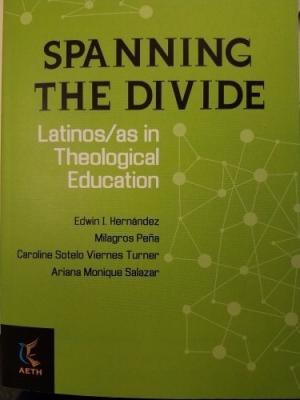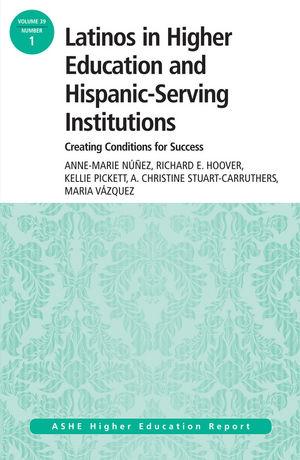Resources

Not a pedagogical tool, “This book provides a detailed look at the current state of Latino/a theological education in the United States” (26). A compilation of research, it begins and ends using data to logically demonstrate the importance of theological education beyond denominations: (1) churches are anchor institutions in areas of poverty that provide critical services which are cost effective; (2) these churches partner to build social capital and personal relationships; (3) seminary educated religious leaders are better prepared to lead such vital churches. However, this is also an issue vital to denominations because demographic and religious adherence data suggest “Hispanic peoples are the future of Christianity” (469). Finally, it is an important issue for seminaries which not only wish to participate in that greater good beyond denomination by addressing diversity, but also wish to attract and retain faculty who are: comparatively young yet experienced, likely to hold more graduate degrees than required and speak more than one language, love teaching and excel as educators, are hard-working and open-minded, view their academic work as a vocation and persevere in their denominational affiliation, and who have a natural proclivity to span divides among races, partisan politics, languages, ethnicities as well as between seminaries and local churches. These are all descriptors of Latina/o faculty. Though lengthy, the book is an easy read due to its helpful introduction and chapters that both provide both an opening summary and concluding recommendations. Chapter ten is the most challenging because it moves the discussion beyond inclusion to justice: “push against tokenism, stereotyping, monocultural curricula….recognizing scholarship and teaching….[push for] greater transparency…” (326). Two chapters provide case studies on seminaries that are models of this inclusive justice. Another chapter describes the worthy efforts of the Hispanic Summer Program and the Hispanic Theological Initiative, both important partners for schools serious about increasing the number of their Latino/a faculty, which is a key take-away because “Latino/as beget more Latino/as” (445). Every positive outcome documented appears predicated on the presence of Latina/o faculty. Chapter thirteen is a groundbreaking study of Bible Institutes. Among the most important recommendations is a kind of mutual mentoring. Latina/o faculty need and want to be mentored; non-Latino/a deans and presidents with good will but poor skills concerning diversity would profit by listening to those faculty. If they do, everyone benefits. Another urgent need is continual training on diversity for faculty, students, staff, administrators, and board members. “Through Hispanic Eyes” (chapter fourteen) serves as an example. Although not exhaustive, the bibliography is comprehensive. An index would have been helpful, and given the repeated assertion that Catholic seminaries compare well to their Protestant counterparts, a case study of a Catholic seminary seems missing. Nonetheless, this is not a book to be shelved or filed, but rather one to spark necessary debate and urgent action.

Much is at stake in the effort to improve the success of Latino/a students in American higher education. The remarkable growth of this population in recent years is expected to continue well into the twenty-first century, and higher education remains one of the surest routes to long-term stability in our society. At the same time, Latino/as continue to lag behind other racial/ethnic groups in higher educational attainment. Recognizing that American colleges and universities were not established with the distinctive needs of the Latino/a demographic in mind, researchers in education have spent the last two decades investigating ways to identify and dismantle barriers to Latino/a success. Each of the five authors in this volume have made significant contributions to this body of research and are well-poised to help guide the reader through the considerable results. This volume, part of a series published by the Association for the Study of Higher Education (ASHE), begins with an overview of the demographic diversity that characterizes the population conventionally designated as Latino/a or Hispanic (the authors use these terms interchangeably). By briefly addressing the distinctive attributes of various ethnic subgroups, the authors highlight the variety of nationalities, languages, and other variables that characterize this population. The pan-ethnic terminology, however, does highlight shared challenges that Latino/a college students often face, including racism, difficulties building community (Chapter 3), and frequent deficiencies in college readiness (Chapter 4). After summarizing research on the most pressing challenges facing Latino/a college students, the authors turn to approaches that have been attempted more broadly, that is those intended to address needs of various under-represented groups (Chapter 5), as well approaches more narrowly focused on the distinctive needs of Latino/a students (Chapter 6). A variety of promising programs are presented, with potential impact on virtually every aspect of college life: academic, financial, cultural, and social. The authors devote particular attention to initiatives that build on the resources Latino/a students already possess. Programs that perceive the strong ties characterizing many Latino/a families as a potential asset, for example, have proven to be more effective than those that cast familial bonds as potentially hindering student success. The clearly written overview of the origins and development of Hispanic Serving Institutions (HSIs) in Chapter 7 adds to the usefulness of the volume, as does the practical recommendations for faculty in the concluding chapter. The authors cite a recent study, for example, which suggests that when faculty are conceptualized as “retention agents,” a healthy shift in institutional norms can occur. Although this volume will be of interest to Religious Studies and Theology faculty and administrators at a variety of institutions, those employed at current or emerging HSIs will find its overview of recent research to be particularly valuable as we strive to enhance our institutional effectiveness with Latino/a students. Indeed, the text suggests that those who teach or work in religion and theology may even have a distinctive role to play; among the cultural patterns or orientations identified as being typically shared by Latino/as is an emphasis on religious faith and spirituality. This orientation suggests that faculty and administrators in these areas are well-positioned to have an impact on the educational experience of our Latino/a students.This well-written survey makes a strong case for prioritizing such efforts.